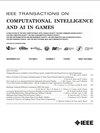重新访问分区搜索
Q2 Computer Science
IEEE Transactions on Computational Intelligence and AI in Games
Pub Date : 2017-03-01
DOI:10.1109/TCIAIG.2015.2505240
引用次数: 3
摘要
分区搜索是博弈搜索的一种形式,由Matthew L.Ginsberg于1996年提出,他写道该方法“结合了依赖性分析,可以大幅减少树中需要扩展的部分。”本文对分区搜索算法提出了一些改进。我们贡献的最重要的扩展,我们称之为局部分区搜索,其有效性已经通过实验验证。所获得的结果(我们在论文中介绍)表明,在桥接的情况下,使用这种扩展可以显著减少搜索树的大小和计算时间(几乎减少一半)。我们提出的另一个扩展允许更有效地使用换位表(使用它来缩小搜索窗口或通过剪切多个条目)。此外,我们还提供了所有分区搜索变体正确性的形式证明。通过减少分区系统的定义限制,我们从中得出了分区搜索的一个可能推广的结论。我们还为双虚桥提供了一个分区系统的形式化定义。本文章由计算机程序翻译,如有差异,请以英文原文为准。
Partition Search Revisited
Partition search is a form of game search, proposed by Matthew L. Ginsberg in 1996, who wrote that the method “incorporates dependency analysis, allowing substantial reductions in the portion of the tree that needs to be expanded.” In this paper, some improvements of the partition search algorithm are proposed. The effectiveness of the most important extension we contribute, which we call local partition search, has been verified experimentally. The results obtained (which we present in the paper) show that using this extension, leads, in the case of bridge, to a significant reduction (almost by half) of the search tree size and calculation time. Another extension we proposed allows for more effective usage of the transposition table (using it to narrow the search window or by cutting more than one entry). Additionally, we contribute a formal proof of the correctness of all presented partition search variants. We draw conclusions from it about a possible generalization of partition search by making the definition of a partition system less restrictive. We also provide a formal definition of a partition system for the double dummy bridge.
求助全文
通过发布文献求助,成功后即可免费获取论文全文。
去求助
来源期刊

IEEE Transactions on Computational Intelligence and AI in Games
COMPUTER SCIENCE, ARTIFICIAL INTELLIGENCE-COMPUTER SCIENCE, SOFTWARE ENGINEERING
CiteScore
4.60
自引率
0.00%
发文量
0
审稿时长
>12 weeks
期刊介绍:
Cessation. The IEEE Transactions on Computational Intelligence and AI in Games (T-CIAIG) publishes archival journal quality original papers in computational intelligence and related areas in artificial intelligence applied to games, including but not limited to videogames, mathematical games, human–computer interactions in games, and games involving physical objects. Emphasis is placed on the use of these methods to improve performance in and understanding of the dynamics of games, as well as gaining insight into the properties of the methods as applied to games. It also includes using games as a platform for building intelligent embedded agents for the real world. Papers connecting games to all areas of computational intelligence and traditional AI are considered.
 求助内容:
求助内容: 应助结果提醒方式:
应助结果提醒方式:


